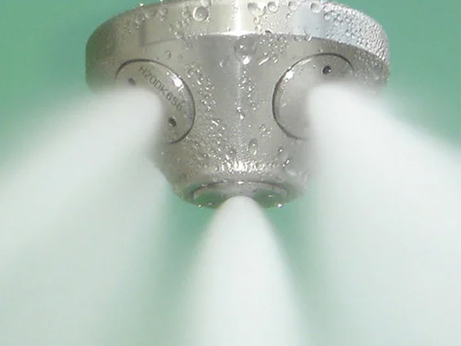Water Mist and Hybrid Water Mist Fire Suppression Systems: An Overview

In the field of fire suppression, technology is constantly evolving to provide more efficient, environmentally friendly, and safe solutions. Among these innovations, water mist and hybrid water mist fire suppression systems have gained significant attention. These systems offer an effective alternative to traditional fire suppression methods, such as sprinklers and gaseous systems, by combining the benefits of water and gas in a single solution. This article explores the key aspects, advantages, and applications of water mist and hybrid water mist fire suppression systems.
What is a Water Mist Fire Suppression System?
A water mist fire suppression system uses fine droplets of water, typically less than 100 microns in diameter, to control and extinguish fires. Unlike traditional sprinkler systems that discharge large volumes of water, water mist systems utilize high-pressure nozzles to atomize water into a fine mist. The small droplet size increases the surface area of the water, allowing it to absorb heat more efficiently and reduce the oxygen concentration around the fire. This dual action of cooling and oxygen displacement makes water mist an effective fire suppression method.
How Does Water Mist Work?
Water mist suppresses fire through three primary mechanisms:
1. Cooling : The fine mist rapidly absorbs heat from the fire, cooling the flames and surrounding gases, which reduces the temperature below the combustion threshold.
2. Oxygen Displacement : The mist expands into steam when it contacts the fire, displacing oxygen in the process. This helps to suffocate the fire by reducing the oxygen concentration to a level where combustion cannot sustain.
3. Radiant Heat Blocking : The mist forms a barrier that absorbs radiant heat, preventing the fire from spreading to adjacent materials and slowing down the fire's growth.
Types of Water Mist Systems
Water mist systems are classified based on the pressure at which they operate:
1. Low-Pressure Systems : These systems operate at pressures below 12.5 bar (180 psi) and are typically used in applications where water supply is limited. They are effective for protecting ordinary hazards, such as office spaces and small machinery rooms.
2. Medium-Pressure Systems : Operating between 12.5 bar (180 psi) and 35 bar (500 psi), these systems are suitable for moderate-risk areas, including storage facilities, electrical rooms, and hospitals.
3. High-Pressure Systems : With pressures exceeding 35 bar (500 psi), high-pressure water mist systems are used in high-risk environments, such as data centers, marine vessels, and industrial plants. The high-pressure mist is particularly effective in penetrating the fire plume and reaching concealed areas.
What are Hybrid Water Mist Fire Suppression Systems?
Hybrid water mist fire suppression systems combine water mist technology with a secondary agent, often an inert gas like nitrogen or carbon dioxide. The integration of gas enhances the fire suppression capabilities of the system, making it suitable for a wider range of fire types, including Class A (ordinary combustibles), Class B (flammable liquids), and Class C (electrical) fires.
In a hybrid system, the inert gas is used to drive the water mist out of the nozzles at high velocity. The gas helps to distribute the mist more effectively, ensuring that it reaches all areas of the fire. Additionally, the gas can provide additional cooling and oxygen displacement, further improving the system's overall effectiveness.
Advantages of Water Mist and Hybrid Systems
1. Water Efficiency: One of the most significant benefits of water mist systems is their ability to suppress fires using significantly less water than traditional sprinkler systems. This makes them ideal for environments where water damage must be minimized, such as museums, libraries, and data centers.
2. Environmental Impact: Water mist systems are environmentally friendly, as they use water, a naturally occurring substance, and produce no harmful byproducts. Hybrid systems, when using inert gases, also have a minimal environmental impact compared to chemical-based fire suppression agents.
3. Safety : Water mist systems are safe for use in occupied spaces, as they do not reduce oxygen levels to dangerous levels like some gas-based systems. The fine mist poses no health risks and can be safely discharged in areas where people are present.
4. Rapid Response : The fine mist generated by these systems can quickly absorb heat and control a fire before it can spread. This rapid response time is crucial in protecting valuable assets and ensuring the safety of occupants.
5. Versatility : Water mist and hybrid systems can be adapted to various environments, from industrial plants to residential buildings. Their ability to control multiple types of fires makes them versatile solutions for comprehensive fire protection.
6. Reduced Water Damage : Traditional sprinkler systems can cause significant water damage to property, often exacerbating the damage caused by the fire itself. Water mist systems, on the other hand, use a fraction of the water, significantly reducing the risk of water damage.
Applications of Water Mist and Hybrid Systems
1. Data Centers : In environments where sensitive electronic equipment is at risk, water mist and hybrid systems offer effective fire suppression without the risk of water damage or electrical conductivity.
2. Marine Industry : The compact nature and effectiveness of water mist systems make them ideal for use on ships, where space and weight are at a premium, and where traditional sprinkler systems may be less effective.
3. Heritage Sites and Museums : Protecting valuable and irreplaceable items from fire and water damage is critical. Water mist systems provide fire protection while minimizing the risk of damaging historical artifacts.
4. Industrial Facilities : In industrial settings, where hazardous materials and processes are common, hybrid water mist systems can provide comprehensive fire protection by addressing multiple fire types.
5. Hospitals and Healthcare Facilities : The safety and minimal water usage of water mist systems make them ideal for healthcare environments, where patient safety and the protection of medical equipment are paramount.
Conclusion
Water mist and hybrid water mist fire suppression systems represent a significant advancement in fire protection technology. Their ability to use water more efficiently, minimize environmental impact, and protect a wide range of environments makes them a preferred choice for modern fire suppression needs. As technology continues to evolve, these systems are likely to play an increasingly important role in safeguarding lives and property from the devastating effects of fire.
(This "Fire Safety Blogs" Published in September 2024 Edition)













